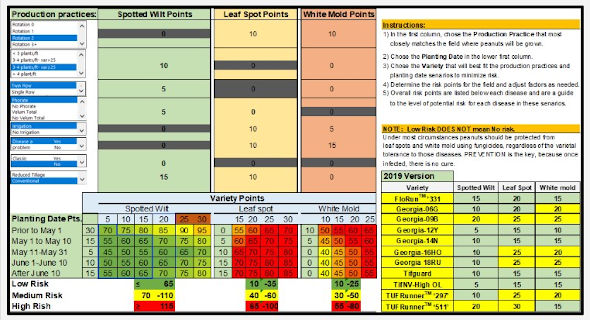By btillman
We have all been surprised and stunned by the rapid spread of the coronavirus all around the world and even into our own neighborhoods. Like many of you, I pray daily for a swift end to this crisis. Be safe out there!
Meanwhile, another virus, one that is not harmful to humans, is lurking and ready to infect our coming peanut crop. Last year (2019), tomato spotted wilt virus (TSWV) made a comeback in southeastern peanuts after a nine-year hiatus. Yes, that’s right, the last time we had appreciable spotted wilt in peanuts at the UF-IFAS research station in Marianna was in 2009. A picture of that very field is shown in Figure 1. Notice the yellow leaves and stunted plants. Spotted wilt reduced yield in this field by an estimated 1,000 pounds per acre.
Figure 1. April planted peanuts at the UF North Florida REC near Marianna, FL in 2009 with symptoms of spotted wilt. Credit: Barry Tillman, UF/IFAS
The good news is that we know a lot about how to minimize the impact of spotted wilt virus on peanut. And, I firmly believe that we will find lifesaving therapies and maybe even a vaccine for coronavirus soon. One resource that we have for helping to minimize spotted wilt virus in peanut is the
Peanut Rx and the related
Peanut Disease Risk Calculator which is a handy tool for visualizing the impact of various management and cultural practices including variety choice on three major peanut diseases including spotted wilt. Simply download the EXCEL file, change the management practices on the left column and watch the risk values change along the bottom of the screen. Lower numbers with green to yellow colors mean low risk, whereas red means high risk (you may need to save the file to a desktop computer for it to work properly; it will not work on an iPad). Figure 2, below, shows a screenshot of the EXCEL version of the calculator.

In closing, it is important to mention that one important factor that has fallen out of favor over the past several years is use of Thimet, an in-furrow insecticide. Thimet is one of several important tools to combat spotted wilt in peanut, and should be included in the arsenal, especially when other risk factors are high.
Source : ufl.edu